仁爱版 七年级 教案 Unit1 Topic2 Section A B C D
- 格式:doc
- 大小:157.00 KB
- 文档页数:18
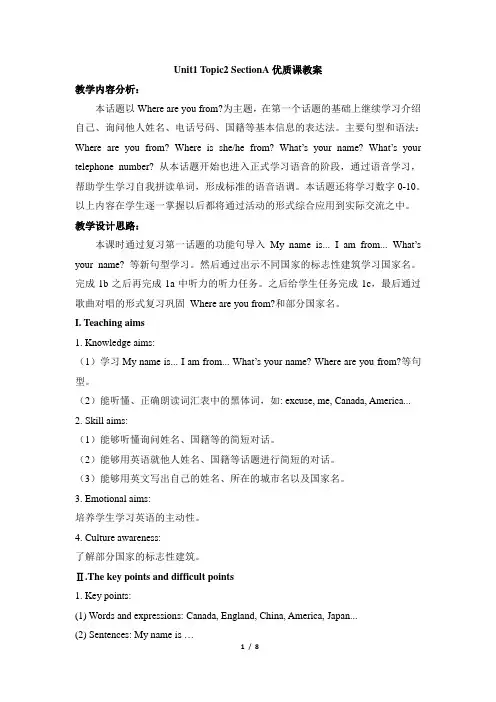
Unit1 Topic2 SectionA优质课教案教学内容分析:本话题以Where are you from?为主题,在第一个话题的基础上继续学习介绍自己、询问他人姓名、电话号码、国籍等基本信息的表达法。
主要句型和语法:Where are you from? Where is she/he from? What’s your name? What’s your telephone number? 从本话题开始也进入正式学习语音的阶段,通过语音学习,帮助学生学习自我拼读单词,形成标准的语音语调。
本话题还将学习数字0-10。
以上内容在学生逐一掌握以后都将通过活动的形式综合应用到实际交流之中。
教学设计思路:本课时通过复习第一话题的功能句导入My name is... I am from... What’s your name? 等新句型学习。
然后通过出示不同国家的标志性建筑学习国家名。
完成1b之后再完成1a中听力的听力任务。
之后给学生任务完成1c,最后通过歌曲对唱的形式复习巩固Where are you from?和部分国家名。
I. Teaching aims1. Knowledge aims:(1)学习My name is... I am from... What’s your name? Where are you from?等句型。
(2)能听懂、正确朗读词汇表中的黑体词,如: excuse, me, Canada, America... 2. Skill aims:(1)能够听懂询问姓名、国籍等的简短对话。
(2)能够用英语就他人姓名、国籍等话题进行简短的对话。
(3)能够用英文写出自己的姓名、所在的城市名以及国家名。
3. Emotional aims:培养学生学习英语的主动性。
4. Culture awareness:了解部分国家的标志性建筑。
Ⅱ.The key points and difficult points1. Key points:(1) Words and expressions: Canada, England, China, America, Japan...(2) Sentences: My name is …I am from ...What’s your name?Where are you from?Excuse me ...2. Difficult points:正确书写国家名。
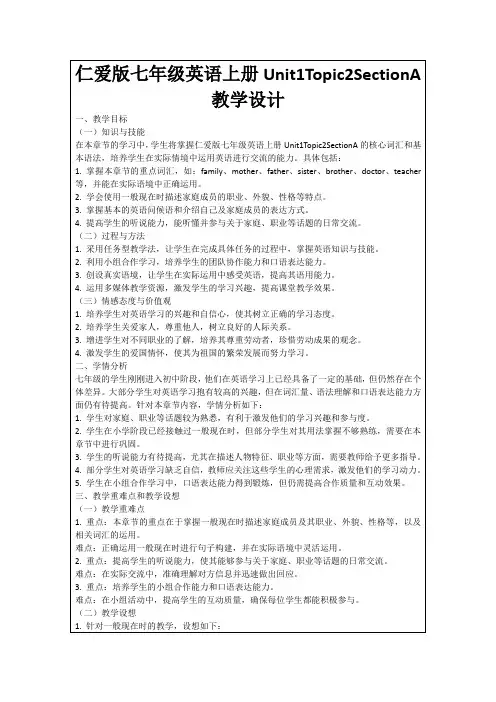
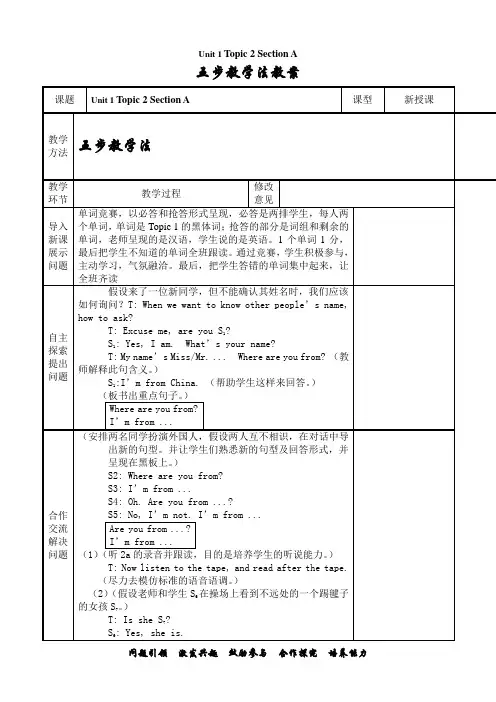
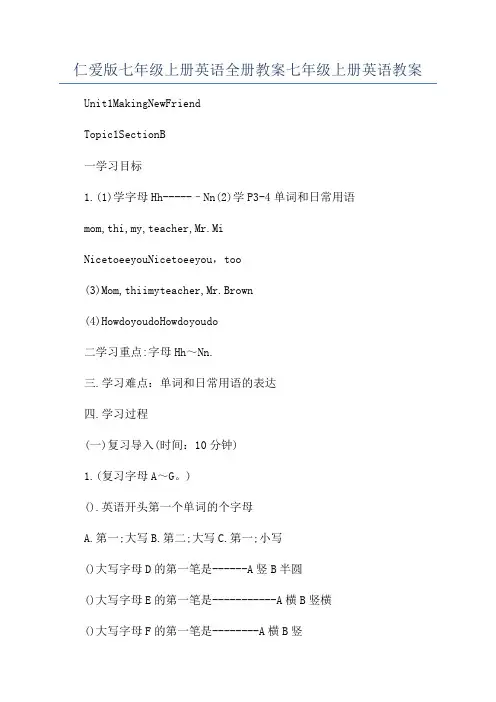
仁爱版七年级上册英语全册教案七年级上册英语教案Unit1MakingNewFriendTopic1SectionB一学习目标1.(1)学字母Hh-----–Nn(2)学P3-4单词和日常用语mom,thi,my,teacher,Mr.MiNicetoeeyouNicetoeeyou,too(3)Mom,thiimyteacher,Mr.Brown(4)HowdoyoudoHowdoyoudo二学习重点:字母Hh~Nn.三.学习难点:单词和日常用语的表达四.学习过程(一)复习导入(时间:10分钟)1.(复习字母A~G。
)().英语开头第一个单词的个字母A.第一;大写B.第二;大写C.第一;小写()大写字母D的第一笔是------A竖B半圆()大写字母E的第一笔是-----------A横B竖横()大写字母F的第一笔是--------A横B竖2.(复习口语交际:说出下列用语的答语)1、Goodmorning!2、Hello!AreyouMaria4、Nicetomeetyou!5、AreyouLiMing(做出肯定回答)-____________________3.(复习上节课的生词:板书下列内容,让学生完成单词。
)(2)—Nicetom____tyou.—Ni____tomeetyou,too.(3)--H__llo(2)(板书字母Hh~Nn,教学字母的写法。
)(三)问题导学()1.在英语字母中大写字母H的第二笔是____A横B竖()2.在英语字母中大写字母I用______笔写完A一笔B三笔()3.在英语字母中小写字母i的第一笔是_______A点B横竖提(四)典题训练写出下列大小写字母的左邻右舍。
1.C2.j3.g4.m5.D6.I7.G8.e9.F10.k11.b12.N13.h14.E15.L(五)精讲点拨:此类型的题目的是让学生们熟练掌握住26个字母的顺序以及相应的大小字母的相互转换,可以先把所学字母按照顺序写好,然后对照所写字母,可以快速准确的写出答案。
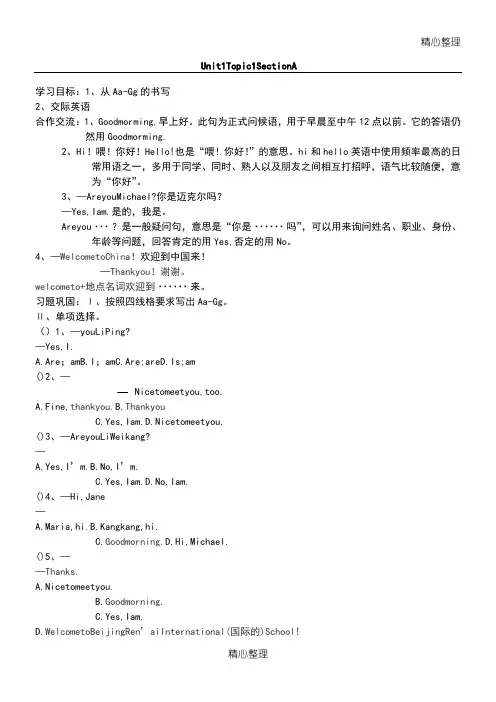
精心整理Unit1Topic1SectionA学习目标:1、从Aa-Gg的书写2、交际英语合作交流:1、Goodmorming.早上好。
此句为正式问候语,用于早晨至中午12点以前。
它的答语仍然用Goodmorming.2、Hi!喂!你好!Hello!也是“喂!你好!”的意思。
hi和hello英语中使用频率最高的日常用语之一,多用于同学、同时、熟人以及朋友之间相互打招呼,语气比较随便,意为“你好”。
3、—AreyouMichael?你是迈克尔吗?—Yes,Iam.是的,我是。
Areyou··年龄等问题,回答肯定的用Yes,4、—WelcometoChina!欢迎到中国来!—Thankyou!谢谢。
welcometo+地点名词欢迎到······来。
习题巩固:Ⅰ、按照四线格要求写出Aa-Gg。
Ⅱ、单项选择。
()1、—youLiPing?—Yes,I.A.Are;amB.I;()2、——A.Fine,thankyou.B.Thankyou()3、——A.Yes,I’m.()4、——A.Maria,hi.B.Kangkang,hi.C.Goodmorning.D.Hi,Michael.()5、——Thanks.A.Nicetomeetyou.B.Goodmorning.C.Yes,Iam.D.WelcometoBeijingRen’aiInternational(国际的)School!Ⅲ、从Ⅱ栏选出对应的答语。
ⅠⅡ()1.Goodmorning.A.Fine,thanks.()2.Hello!B.Nicetomeetyou,too.()3.Nicetomeetyou.C.No,Iamnot.()4.IamKangkang.AreyouMaria?D.Goodmorning.()5.Howareyou?E.Hi,Mr.Zhang.Unit1Topic1,SectionB 学习目标:1.字母的书写。
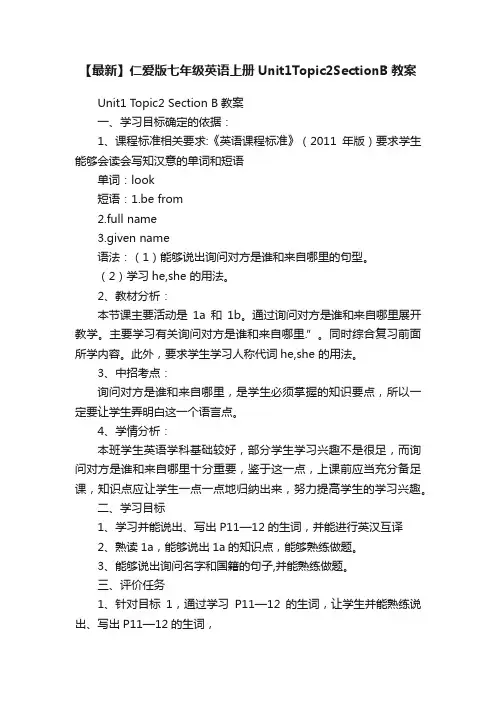
【最新】仁爱版七年级英语上册Unit1Topic2SectionB教案Unit1 Topic2 Section B教案一、学习目标确定的依据:1、课程标准相关要求:《英语课程标准》(2011年版)要求学生能够会读会写知汉意的单词和短语单词:look短语:1.be from2.full name3.given name语法:(1)能够说出询问对方是谁和来自哪里的句型。
(2)学习he,she 的用法。
2、教材分析:本节课主要活动是1a和1b。
通过询问对方是谁和来自哪里展开教学。
主要学习有关询问对方是谁和来自哪里.”。
同时综合复习前面所学内容。
此外,要求学生学习人称代词he,she 的用法。
3、中招考点:询问对方是谁和来自哪里,是学生必须掌握的知识要点,所以一定要让学生弄明白这一个语言点。
4、学情分析:本班学生英语学科基础较好,部分学生学习兴趣不是很足,而询问对方是谁和来自哪里十分重要,鉴于这一点,上课前应当充分备足课,知识点应让学生一点一点地归纳出来,努力提高学生的学习兴趣。
二、学习目标1、学习并能说出、写出P11—12的生词,并能进行英汉互译2、熟读1a,能够说出1a的知识点,能够熟练做题。
3、能够说出询问名字和国籍的句子,并能熟练做题。
三、评价任务1、针对目标1,通过学习P11—12的生词,让学生并能熟练说出、写出P11—12的生词,并能进行英汉互译。
2、针对目标2,通过熟读1a,能够说出1a的知识点,能够熟练做题。
3、针对目标3,通过举一些例句,让学生能够说出询问名字和国籍的句子,并能熟练做题。
四、教学过程学习教学活动评价要点要点归纳目标目标自学指导11:学习并能说出、写出P11—12的生词,并能进行英汉互译1.自学内容:课本P11—12的生词。
2.自学方法:先根据音标试读,同桌互相正音,提问。
3.自学时间:5分钟4.自学要求:会读,知道其汉语意思,并能英汉互译。
Step3学生看书自学,教师巡视辅导。
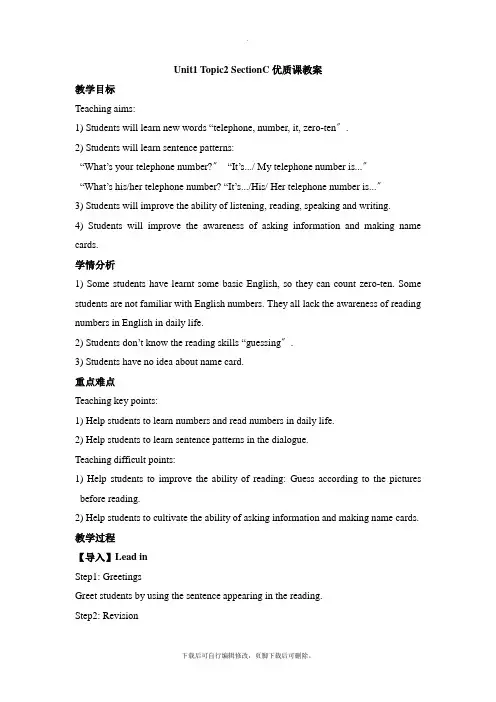
Unit1 Topic2 SectionC优质课教案教学目标Teaching aims:1) Students will learn new words “telephone, number, it, zero-ten〞.2) Students will learn sentence patterns:“What’s your telephone number?〞“It’s.../ My telephone number is...〞“What’s his/her telephone number? “It’s.../His/ Her telephone number is...〞3) Students will improve the ability of listening, reading, speaking and writing.4) Students will improve the awareness of asking information and making name cards.学情分析1) Some students have learnt some basic English, so they can count zero-ten. Some students are not familiar with English numbers. They all lack the awareness of reading numbers in English in daily life.2) Students don’t know the reading skills “guessing〞.3) Students have no idea about name card.重点难点Teaching key points:1) Help students to learn numbers and read numbers in daily life.2) Help students to learn sentence patterns in the dialogue.Teaching difficult points:1) Help students to improve the ability of reading: Guess according to the pictures before reading.2) Help students to cultivate the ability of asking information and making name cards. 教学过程【导入】Lead inStep1: GreetingsGreet students by using the sentence appearing in the reading.Step2: RevisionShow some pictures to review sentence patterns “Where are you from?〞“Where is he/she from?〞“Is she/he from ...?〞Step3: Lead-inUse “TFboys are my friends〞to introduce “telephone, telephone number, and English numbers.〞【讲授】Pre—readingStep1. Learn English numbers:①Ask students to count from zero to ten and count from ten to zero.②Listen, follow and speak.③Check students’ ability of speaking English numbers by playing a game “Who has good eyes? 〞④Ask students to read numbers in life.Step2. Learn sentence patters:①Learn “What’s your telephone number?〞“It’s... /My telephone number is...〞.②Practice the sentence patterns by giving students a real situation.③Group work to practice “What’s his/her telephone number?〞“Its.../His /Her telephone number is...〞.【讲授】ReadingStep1: Look at the four pictures on page 13 and guess what happened.Step2: Listen to the conversation and check the guessing.Step3: Read the conversation and finish the name card.【活动】Post-readingStep1: Listen, read and act out the conversation.Step2: Group work: have a conversation with the deskmates and make a name card. 【练习】Homework1. Use the sentences what we have learnt to make a new dialogue.2. Make a name card of yourself including as much information as possible.。
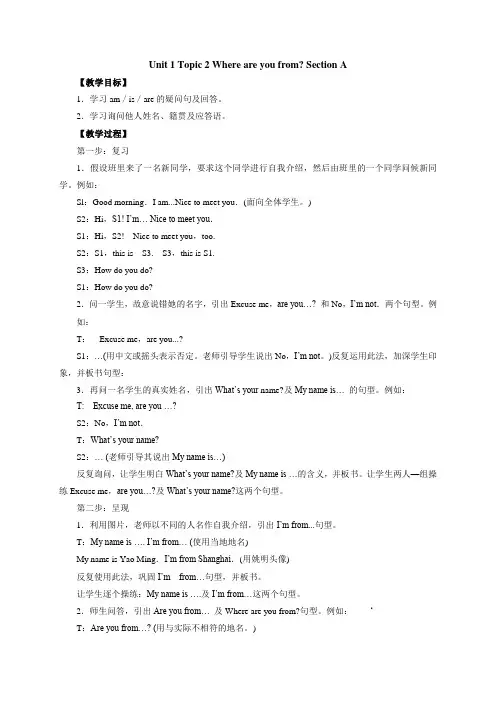
Unit 1 Topic 2 Where are you from? Section A【教学目标】1.学习am/is/are的疑问句及回答。
2.学习询问他人姓名、籍贯及应答语。
【教学过程】第一步:复习1.假设班里来了一名新同学,要求这个同学进行自我介绍,然后由班里的一个同学问候新同学。
例如:Sl:Good morning.I am...Nice to meet you.(面向全体学生。
)S2:Hi,S1! I’m… Nice to meet you.S1:Hi,S2! Nice to meet you,too.S2:S1,this is S3. S3,this is S1.S3:How do you do?S1:How do you do?2.问一学生,故意说错她的名字,引出Excuse me,are you…? 和No,I’m not.两个句型。
例如:T:Excuse me,are you...?S1:…(用中文或摇头表示否定。
老师引导学生说出No,I’m not。
)反复运用此法,加深学生印象,并板书句型:3.再问一名学生的真实姓名,引出What’s your name?及My name is… 的句型。
例如:T: Excuse me, are you …?S2:No,I’m not.T:What’s your name?S2:… (老师引导其说出My name is…)反复询问,让学生明白What’s your name?及My name is …的含义,并板书。
让学生两人—组操练Excuse me,are you…?及What’s your name?这两个句型。
第二步:呈现1.利用图片,老师以不同的人名作自我介绍,引出I’m from...句型。
T:My name is …. I’m from… (使用当地地名)My name is Yao Ming.I’m from Shanghai.(用姚明头像)反复使用此法,巩固I’m from…句型,并板书。
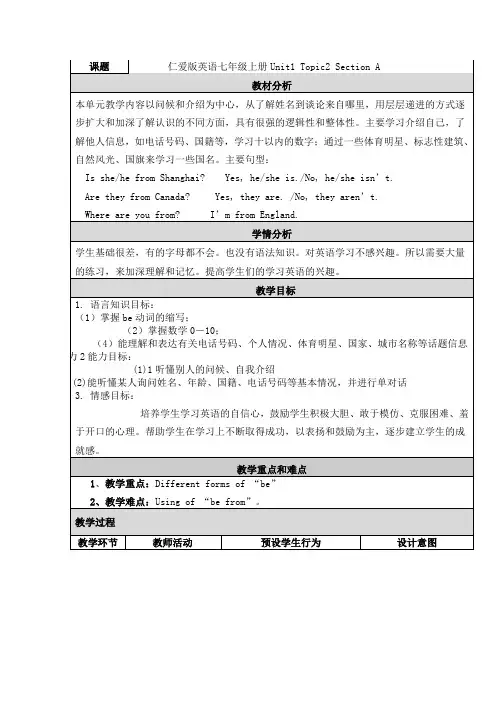


Unit2 Topic1 SectionA 优质课教案I.教学目标1. Learn some new words:(1) Learn words about parts of the body: nose, eye, head, face, hair, ear, mouth, neck.(2) Learn some other new words: guess, have, small, has, big, know, right, round, long, wide, girl, boy, short.2. Learn some useful sentences:(1) Oh, I know.(2) Yes, you’re right.3. Learn the simple present tense with “have/has” and adjectives of description:(1) I have a big nose.(2) They have round faces.(3) She has long hair.(4) It has big ears.4. Learn how to describe people’s appearances.Ⅱ.教具黑板、幻灯片课件Ⅲ.教学过程Step1借助体态语,帮助学生学习语言,并培养他们的观察能力。
1.(教师利用手势唱the Body Song,教师应按照从上到下、从局部到整体的手指人体部位,以便帮助学生记忆。
)Please listen and follow me, I will teach you a body song. Show me your hands and follow me. Please pay more attention to my fingers. I will touch the parts of my body. Let’s go!2.(利用2a的教学幻灯片,操练表示人体部位的名词。
Unit 1 Making New FriendsTopic 2 Where are you from?Section AThe main activities are 1a and 2a. 本课重点活动是1a和2a。
Ⅰ. Teaching aims and demands 教学目标1. Learn some personal pronouns and possessive pronouns:me, your, she, he, we2. Learn some country names:Canada, Japan, England3. Learn other new words and phrases:excuse, excuse me, what, name, where, from, be from, the4. Talk about people’s names and where they are from:(1)—Excuse me, are you Jane?—Yes, I am.(2)—What’s your name?—My name is Sally.(3)—Where are you from?—I’m from Canada.(4)—Are you from Canada, too?—No, I’m not.(5)—Is he/she …?—Yes, he/she is./No, he/she isn’t.(6)—Where is he/she from?—He/She is from …Ⅱ. Teaching aids 教具卡片/教学挂图/录音机Ⅲ. Five-finger Teaching Plan 五指教学方案Step 1 Review 第一步复习(时间:10分钟)通过对话,复习Topic 1的见面问候语,并导入本课新单词和新句型。
1. (师生问候,复习前一话题所学知识,为此课学习作铺垫。
仁爱版七年级上册英语教学设计:Unit 1 Topic2 Section C教学重点难点:1.Words: zero, one, two, three, four, five, six, seven, eight, nine, ten telephone, number, it2. Sentences:--What’s your telephone number?—My telephone number/It is 6800-3553.3.能够正确使用表达感谢和回谢的功能句:—Thank you very much. —That’s OK.教学过程设计教学环节教学内容教学策略预设时间Step1:导入①唱英文歌曲“Where are you from?”, 活跃课堂气氛。
②复习句型“Who is he/s he?”和“Where ishe/she from?”及答语。
③引导学生学习并掌握生词telephone和number;利用自己的电话导入数字学习。
Step2:呈现①根据图片,读出每个数字的英文读音,引导学生学习表示数字0—10的生词。
②听录音,跟读课文1a,让学生模仿语音语调,然后齐读,完成1a。
Step3巩固①看图读数字,完成1b中B部分练习。
②运用所给图片中的各种号码,让学生练习读、写数字。
(幻灯片7—13)Step4:练习①听1a录音,让学生跟读并模仿语音语调。
②两人一组问答,完成1a,然后挑几组同学到前面表演。
③模仿1a, 制作名片,进行两两对话。
④利用小组比赛方式巩固所学内容。
⑤学习音标。
(幻灯片14--20。
注:幻灯片14、15,点击视频P13-1a链接课文1a;幻灯片19,点击括号中的英语,如:two stars可实现超链接。
)Step5;小结——①学习数字0—10。
②学习询问别人的电话号码、名字、国籍及如何应答。
③学习制作名片。
(幻灯片21)Step6:作业——①描述自己的真实情况(姓名、国籍和电话号码),并制作名片。
《仁爱英语》七年级(上)Unit 1 Topic2 Where are you from? Section C说课稿一、教材分析(说教材)1、教材概述本单元的学习有两个重要内容,即数字0~10以及如何询问别人的电话号码及应答。
在学习时,可以联系身边的号码,如邮编及其它常用号码.因为练习学生身边的号码,你的能使语言知识在真实的情景中得到运用,而且容易激发学生兴趣,调动其积极性,同时营造生动有趣的课堂气氛,使学生在宽松的气氛中学习,易于受到最佳的学习效果。
整个部分的活动兼顾听、说、读、写四项技能的训练,活动内容和方式多样化,且重点突出。
教学中的各项活动一直围绕描述号码及其表达展开,使整个部分的教学目标落到实处。
2、重点与难点基于对教材的地位和作用的分析及学生大部分都羞于开口讲英语这一实际情况,结合本节课考点。
我把本节课的重点和难点定为:重点:①掌握、运用新的词汇及重点词组(telephone 、number、it、very much 、that、zero、one、two、three、four、five、six、seven、eight、nine、ten、her、family等)②能熟练应用 ---What’s your... number?---It’s/My ...number is/It is...难点:①使学生真正掌握重要语言点并内化为自己的知识②让每个学生都开口说英语;养成看到就能说出说英语的习惯3、教学目标:《英语课程标准》中要求:初学生能用听懂有关熟悉话题的谈话,并从中获取信息和观点;能就简单的话题提供信息,表达简单的观点和意见,参与讨论;能与他人沟通信息,合作完成任务;能根据话题进行情景对话;能简单描述人物或事件。
且英语教学的目的是培养学生运用语言进行交际的能力,为用而学,在用中学,学了就用。
因此,结合教学重难点我把本单元的教学目标定为以下4个方面:1.语言知识(1)词汇①掌握telephone 、number、it、very、 much 、that、zero、one、two、three、four、five、six、seven、eight、nine、ten、her、family等20个单词和词组。
Unit2 Topic1 Section A学习目标:1.复习who提问的句型。
2学习单词:head hair eye ear nose mouth face bigwide small long round short3.掌握have/has的用法。
学习重点和难点:1.have/has的用法。
2 .学习新单词。
学习过程:1.自主学习A:Who are you?B:I’m …A:Who is he/she?B:He/She is…2.合作交流,语言点导学(1)I have a small nose,but he has a big one.我长着一个小鼻子,但他长着一个大鼻子。
has是have的第三人称单数,当主语是she,he,it时用has;当主语是I,you,we,they时用have.如:Kangkang has big eyes.I have a small mouth.(2) She has long hair .她留着长发。
long hair 前没不定冠词a,因hair是不可数名词,它没单复数,不用a/an.学习巩固1.单项选择(1)He ____a big head.A.has B.have C.is(2)Mr.Lee has ____short hair, ____small nose and ____wide mouth.A.a;a;aB.a; the; /C./; a; a(3)His____are small, but his nose is big.A.hair B.eyeC.ears(4) ------ Are you Li Ping?------Yes,_________.A.he’sB.you’re rightC.I’m(5)This is my friend.____nose is big. A.He B.His C.She(6)-----Is he Kangkang?------____________.A.Yes, he is.B.Yes, he isn’t.C.No,he is.年级: 七年级科目:英语内容:Topic1SectionB学习目标:1 学习人体各部分名称,能够描述自己的外貌特征;2 熟练使用have/has陈述,疑问和回答。
Topic 2 Where are you from?Section AThe main activities are 1a and 2a. 本课重点活动是1a和2a。
Ⅰ. Teaching aims and demands 教学目标1. Learn some personal pronouns and possessive pronouns:me, your, she, he, we2. Learn some country names:Canada, Japan, England3. Learn other new words and phrases:excuse, excuse me, what, name, where, from, be from, the4. Talk about people’s names and where they are from:(1)—Excuse me, are you Jane?—Yes, I am.(2)—What’s your name?—My name is Sally.(3)—Where are you from?—I’m from Canada.(4)—Are you from Canada, too?—No, I’m not.(5)—Is he/she …?—Yes, he/she is./No, he/she isn’t.(6)—Where is he/she from?—He/She is from …Ⅱ. Teaching aids 教具卡片/教学挂图/录音机Ⅲ. Five-finger Teaching Plan 五指教学方案Step 1 Review 第一步复习(时间:10分钟)通过对话,复习Topic 1的见面问候语,并导入本课新单词和新句型。
1. (师生问候,复习前一话题所学知识,为此课学习作铺垫。
)T: Good morning, class!Ss: G ood morning, Miss Wang!T: Nice to see you.Ss: N ice to see you, too.T: How are you today?Ss: F ine, thanks. And you?T: I’m OK.(转向一名学生向他询问问题并示意他回答。
)T: Hello, are you Xiao Ming?S1: Yes, I am.T: Nice to meet you.S1: Nice to meet you, too.T: This is Xiao Gang.S1: How do you do? Xiao Gang.S2: How do you do?(反复操练见面问候语,让学生充分复习第一话题所学内容。
)2. (拿出准备好的卡片进行问答,卡片上写有Canada, England, the U.S.A., Japan, Cuba, China 国家名称,背面写有来自相应国家的人物Jane, Tony, Sally, Yukio, Maria, Kangkang。
) T: Who is this?(教师解释并示意学生回答。
)Ss: T his is Jane.T: Great, she is Jane, and she is from Canada.)T: Who is this?(拿出Tony的图片。
)Ss: T his is Tony.(帮助回答并领读Tony。
)T: Great, he is Tony, and he is from England.)T: Excuse me, who is she?(拿出Sally的图片。
)Ss: S he is Sally.(帮助回答并领读Sally。
)T: Where is she from?(教师解释并领读此句。
)Ss: S he is from the U.S.A.(帮助回答。
)和where;理解the U.S.A.。
)T: Excuse me, what’s your name?(拿出Yukio的图片给其中的一个学生。
)S3: My name is Yukio.(帮助学生回答。
)T: Where are you from?(老师解释并领读此句。
)S3: I am from Japan.(帮助回答。
))拿出康康的图片。
)Ss: Y es, he is.T: Is he from Japan?Ss: N o, he isn’t.(帮助学生回答。
)(板书并要求学生理解。
)Ss: H e is from China.T: Are we from China?(老师解释并做相应的手势表示“我们”。
)Ss: Y es, we are.(帮助学生回答。
))Step 2 Presentation 第二步呈现(时间:8分钟)通过询问名字和国籍来了解新认识的人,培养学生学习英语的兴趣。
1. (出示1a教学挂图,让学生观察人物,猜测她们之间的对话内容。
设置听力任务,播放1a录音。
)T: Look at the picture. Guess what they are talking about. Now let’s listen to 1a and answer the2. (再次播放1a录音,让学生跟读并模仿对话内容,注意语音语调。
)T: Now let’s listen to 1a again and read after it. Pay attention to the pronunciation and intonation.3. (让学生独自朗读1a,并找出关键句型,根据关键句型进行对话练习,完成1a。
)T: Read 1a by yourselves, and find out the key sentence patterns in 1a. Then practice the conversation according to the key sentence patterns in pairs.Step 3 Consolidation 第三步巩固(时间:8分钟)通过反复操练询问名字和来自的地方的句型,巩固所学目标语言,以达到运用英语进行交流的目的。
1. (结合学生的自身情况,给学生两分钟时间,两人一组操练如下句型。
让学生站起来或到台前来表演。
)T: Now work in pairs. Act out the conversation with your own names in two minutes. You can practice like this:—Excuse me, are you …?—Yes, I am. What’s your name?—My name is …2. (再给学生两分钟时间,两人一组操练下列句型。
要求学生首先使用本课所学的国家名称来表演,然后再用自己的真实的情况如所在区或村来表演。
方式同上。
)T: I’ll give you another two minutes. Make similar dialogs like this :—Where are you from?—I’m from … Are you from …?—No, …I’m from …Example:S1: Where are you from?S2: I’m from Zhongguancun. Are you from Zhongguancun?S1: No, I’m not. I’m from Bagoucun.3. (将上述两步结合起来表演,完成1b。
)T: Now make your own conversations according to 1a. Finish 1b.Example:S3: Excuse me, are you Wang Wei?S4: Yes, I am. What’s your name?S3: My name is Li Lei. Where are you from?S4: I’m from Beijing. Are you from Beijing, too?S3: No, I’m not. I’m from Shanghai.Step 4 Practice 第四步练习(时间:12分钟)学习用第三人称询问名字和来自的地方的句型,培养学生综合运用语言的能力,提高他们学习英语的积极性。
1. (出示2a教学挂图,让学生特别注意图片中远处的人,帮助学生学会知识的迁移,即由第一、二人称的学习过渡到第三人称的学习。
让学生根据所给句型造句。
)T: Look at the pictures, who is she/he? Where is she/he from? You can make the sentences like this:—Is she/he …?—Yes, she/he is. / No, she/he isn’t. She/He is …—Where is she/he from?—She/He is from …2. (播放2a录音,核查学生自主造句的正误。
)T: Listen to 2a and check your answers.3. (两人一组操练对话。
完成2b。
)T: Practice the conversations with your partner. Act out your conversations.4. (分组活动。
两人一组合作完成3。
最后师生共同核对答案。
)T: Let’s finish 3 in pairs.5. (挑几组学生朗读3,注意语音语调。
)6. (出示4的图片,图文结合,让学生加深对国家名称的记忆,并了解各国的标志性建筑或象征物。
播放4录音,完成4。
师生共同核对答案。
)T: Now please listen and number the pictures. Then listen again and match the names with theright countries.7. (让学生自主完成5。
提醒学生注意画线的部分,归纳总结首字母大写的情况及标点符号的使用情况。
)T: Please copy the sentences in 5. Pay attention to the underlined parts.Step 5 Project 第五步综合探究活动(时间:7分钟)通过找字母游戏和名人会活动,帮助学生记忆单词并培养学生熟练运用英语交流信息的技能,培养学生学习英语的兴趣。
1. (找字母游戏:把Section A的单词字母杂乱地写在黑板上,让学生挑选字母组成单词。